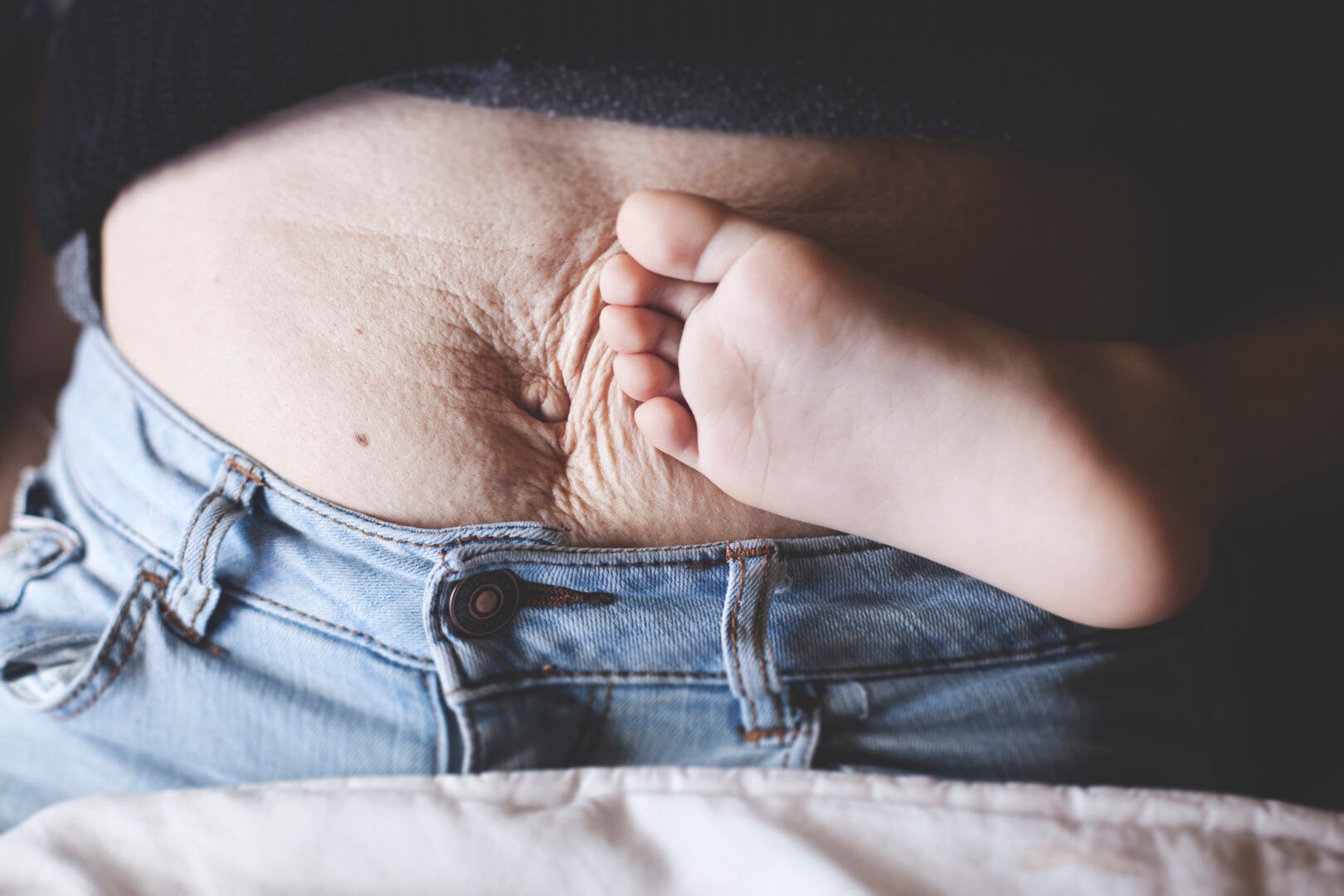Most first-time moms can’t wait for that magical moment when they look at themselves in the mirror and finally catch their first glimpse of that greatly anticipated baby bump. It’s the first obvious sign that you are growing a little life in your belly, and soon-to-be mamas spend the next few months happily taking photo after photo of their growing bellies and proudly posting their bump pics on social media. Fast-forward another seven months or so, and new moms find themselves cursing what remains of their post-pregnancy belly as they desperately wait for their body to “go back to normal.” But what is “normal” after giving birth?
When every magazine cover you see focuses on celebrity moms losing their baby weight, it’s little wonder that new moms feel pressure to erase all signs that their bodies have just housed and birthed a little human. Spoiler alert: Your body will never be exactly the same as it was before you got pregnant. The best thing any new mom or mom-to-be can do for herself is to get a real understanding of how, why and when her body will change in the months after birth. The next, and most crucial, step is to find a way to love and celebrate that postpartum belly. After all, it worked so hard to keep your little one safe in there for all those months.
We talked to Dr. Sherry A. Ross, an OB-GYN and author of “She-ology. The Definitive Guide to Women’s Intimate Health. Period” to get the facts on why your belly looks the way it does after birth. We also spoke with four moms about their postpartum stomachs and how they learned to love their bodies as they are.
Why does my postpartum belly still look pregnant, and how long will it take to go down?
During pregnancy, your uterus has to expand to make room for your growing baby. As it expands, it rises and moves its position to be right above your pubic bone; that’s when you see that first little pregnancy bump. It takes a full nine months for your uterus to go through this process as it slowly shifts and expands within your body.
After giving birth, new moms are often surprised to find that they still look a little pregnant for a few weeks, but it makes sense. Your uterus is still shrinking and finding its way to its original position, and, for most moms, this can take up to three months.
“Immediately after delivery, the uterus will be at the level of your belly button, which is reminiscent of being 20 weeks pregnant,” Ross says. “Women tend to look pregnant for another six to nine weeks as the uterus and saggy, post-baby belly find their way back to normal.”
Will the loose skin on my post-pregnancy belly return to normal?
As for that loose skin you may have? It’s also a side effect of your belly getting bigger during pregnancy. As your belly stretches out to accommodate your growing baby, the collagen and elastin fibers that make up your skin can snap or rupture and it can take a lot of time for your skin to go back to normal. In some cases, it may never go back completely, and a lot of that is due to genetics. Drinking lots of water, eating a healthy diet and exercising are all ways you can try to minimize that loose skin.
“After you deliver your baby either by C-section or vaginally, your uterus and flappy belly skin need time to get back to their pre-pregnant status,” says Ross. “I always tell my patients, give yourself a full nine months to recover completely after having a baby. After all, you have just gone through a physical, emotional and hormonal storm!”
“I always tell my patients, give yourself a full nine months to recover completely after having a baby.”
Dr. Sherry A. Ross, OB-GYN
Is there anything I can do to get rid of stretch marks on my postpartum belly?
Stretch marks occur when you lose or gain weight quickly — something that certainly happens during pregnancy. The elastin and collagen in your skin stretching too far and rupturing is the culprit behind stretch marks as well. Creams and oils can reduce itchiness by moisturizing your skin, but they won’t get rid of stretch marks.
“Stretch marks are genetically determined, which means if your mom got them, especially during pregnancy, you probably will, too,” says Ross. “Using creams and gels rarely make much of a difference in their appearance, but I am a true believer that coconut oil has a lot of health benefits for hydrating the skin. Fortunately, stretch marks fade with time and become silvery white or red, but rarely disappear completely.”
“Fortunately, stretch marks fade with time and become silvery white or red, but rarely disappear completely.”
Dr. Sherry A. Ross, OB-GYN
What is diastasis recti, and can that affect the way my postpartum belly looks?
During pregnancy, your growing uterus causes the muscles in your abdomen to stretch to accommodate it. “Every pregnant woman is familiar with the protruding ridge that is easily seen going down their belly when they go from a lying to sitting position,” Ross says. “This ridge normally separates the abdominal muscles. They can become overly stretched causing a more pronounced separation called diastasis recti. The growing uterus will appear more forward.”
Although that never-disappearing belly pooch could be a sign you’re dealing with diastasis recti, it’s a condition that needs to be identified with the help of your doctor or a qualified physical therapist. If you’re diagnosed with it, your best course of action is to work with a certified physical therapist who specializes in postpartum moms, diastasis recti and other conditions that affect the core.
How four moms learned to love their post-pregnancy belly
While you may make peace with the fact that your postpartum body will always be different than it was pre-kids, you may still struggle with how you feel in your skin post-baby. We talked to four moms who shared how they learned to appreciate and celebrate their postpartum belly — and body.
Don’t stop celebrating your body just because you aren’t pregnant anymore
“During pregnancy, your belly is celebrated, and you yourself may even love its fullness and roundness, but after you have the baby, it is instantly different,” says Renee Evans, a mom of three from California and an Instagram influencer, who uses her social media to share her photography and daily life with other moms. “I felt shocked by and very ashamed of my postpartum belly, especially with my first child. I did not expect to feel this way, and I wanted it to go away.”
“During pregnancy, your belly is celebrated, and you yourself may even love its fullness and roundness, but after you have the baby, it is instantly different.”
Renee Evans, mom of three
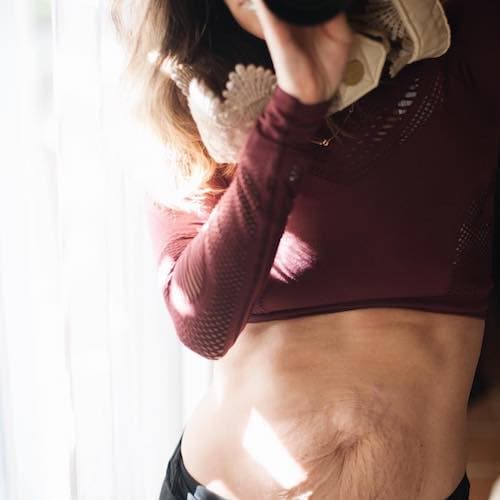
Evans makes a valuable but infrequently discussed point: It can feel like overnight, women go from hearing positive comments about their pregnant bellies to being bombarded with imagery and advice that focuses entirely on erasing all evidence that you were ever pregnant in the first place. Most moms may not even realize that they’re internalizing that change in messaging, and it’s important to realize it does happen and to question why.
Katie Crenshaw, a mom of three from Atlanta, who uses her Instagram presence to encourage other moms to celebrate their postpartum bodies agrees.
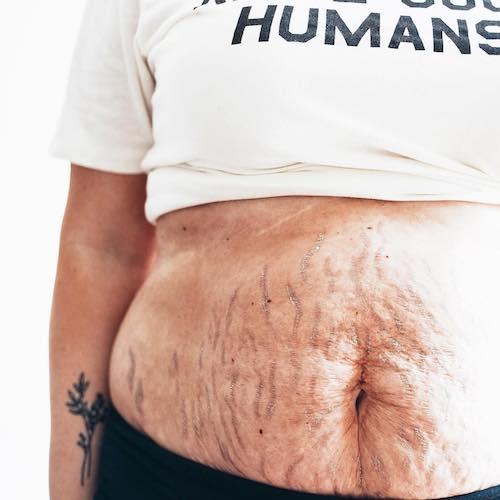
“We love our pregnant bellies,” Crenshaw says. “We rock the bodycon dresses, take selfies and we have so much respect for our mid-section during that time. We even show it off. We are so confident in our bodies for nine months. So, why do we stop?”
Realize that you are so much more than your body
While she urges her fellow moms to love their postpartum bodies, Crenshaw stresses the importance of realizing that you are so much more than what you see in the mirror.
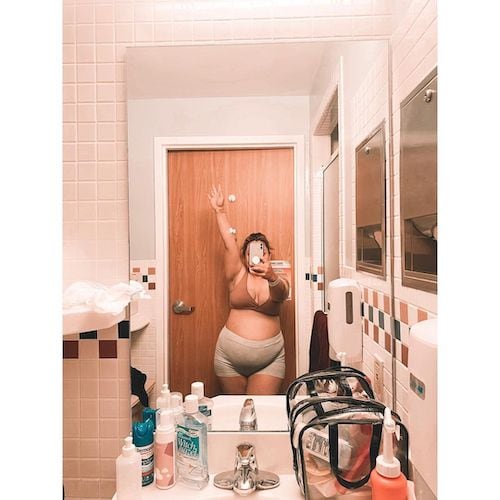
“I’m going to be honest. I don’t love my physical body every day,” she says. “Every day, I love my soul. Every day, I love my spirit and my heart, my tenacity and my purpose and my true self, and here’s my secret: When you love your true self unconditionally, honoring and accepting a body that holds the person you adore becomes much, much easier.”
Focus on getting stronger — not thinner
“After I had my third child, I set a goal for myself to just go to the gym every single day for two weeks and see where that led me,” says Evans. “I did not set a physical goal or put any numbers in my head. That was too overwhelming. I only wanted to focus on creating a habit. My body started changing and becoming stronger, and, of course, that was so motivating. I started to be able to do things that I wasn’t ever able to do before. It was empowering and gave me a whole new appreciation for my body.”
Brenda Rivera Stearns, a mom of five from Ohio and Instagram influencer who writes about motherhood and homeschooling her children, also finds inspiration in focusing on how strong her body already is and how much stronger it can be.
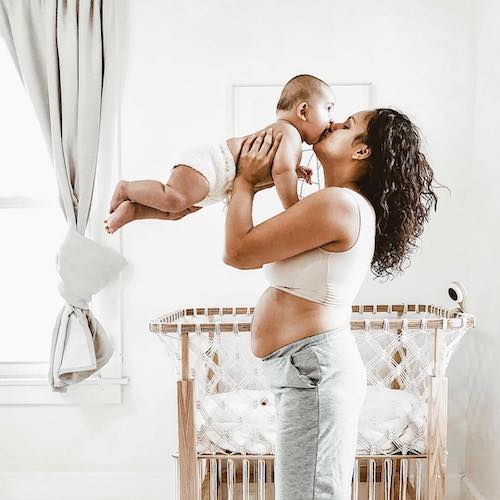
“It’s impressive how much my body has gone through,” says Stearns. “But it’s also changed in other ways. My body now is stronger. I have a higher tolerance for physical pain. My body loves deeper. My body can hold five babies. This body is capable of loving so much more than that pre-pregnancy one. I have physical goals I want to reach. I want to be healthy and strong and stay active throughout my days. I have my moments when I feel ‘ugly,’ and I usually snap out when I remind myself how far I’ve come.”
Try to see yourself through your kids’ eyes
If you’re feeling a little down about the way you look, sometimes the best solution is to switch perspectives temporarily — think about how your child sees you. To them, you are a superhero and they adore the body that gives them hugs and cuddles and makes them feel safe when they are afraid. Even that newborn who can’t yet communicate with you through words loves your body because it gives them the warmth and love they needs to grow bigger every day.
“My kids have helped me realize that it doesn’t matter what my body looks like, they see me for who I am inside,” says Stearns. “They make me a better person. Society wants to label us as flawed, but I am here to remind all of us that, to our children, we are perfect. They see behind the stretched out skin, marks and lines. They see us for who we truly are. They know our hearts and love us unconditionally. And that is all that matters.”
Understand that it will take time and effort, but you can fall in love with your postpartum belly
“It took my almost two years after the triplets’ birth to find beauty and comfort in my new body,” says Desiree Fortin, a mom of triplets from Encinitas, California, who connects with other moms about postpartum struggles on her Instagram account. “It’s amazing how much perspective can change, because I see my body now and find it so beautiful. I appreciate it for all it has done. But it took time and the choice to change my perspective!”
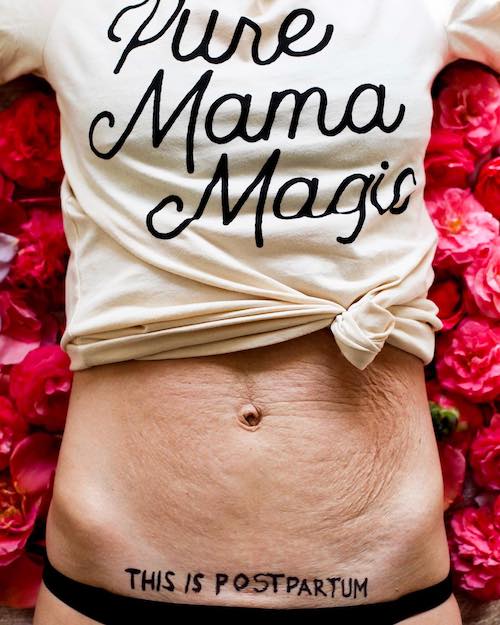
Evans says it wasn’t until after her third pregnancy that she began to truly look at her postpartum body differently. “My belly will never look the same again and that is fine, because it tells my story; it’s the story of my body growing life,” she says. “Our bodies are amazing and resilient, and we are capable of so much. I am at the point where I am so proud of my body. It’s not perfect by any means, but it is mine, and it’s the only one I’ll ever get, so I want to take care of it and feel good about it.”
